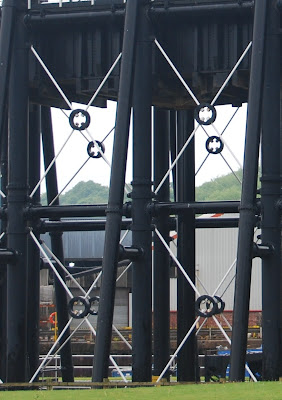Yesterday I visited The Workhouse at Southwell, a place which has long been on my "To go" list, but I was spurred into action by the OCA blog about Maggy Milner's work "A Delicate Balance".
After a lengthy drive, I eventually arrived and was amazed by the size of the workhouse. It is a very large building and seems out of proportion for the needs of the rural community I had driven through. I later went into Southwell itself to find a small town, so perhaps my first impressions were misled by the direction I had travelled from.
I watched an introductory film about the Workhouse' history and the principles behind it. Then I went into the buildings themselves and was surprised by the quality of the building itself, although the amenities for the people living there were spartan.
In the men's exercise yard I came across the first piece of Maggy's work, "Hard Labour".
The various sizes of hands represented the ages of all the occupants of the workhouse and the very physical hard work they had to perform. The piece looked even more dramatic when seen from inside the building on the upper floors. It was quite chilling. The position of each hand seemed to suggest a silent plea for the toil to stop.
The ground floor of the workhouse was spotlessly clean, dry and sparsely furnished, but then I went into the cellars which were less inviting. It was cold, dark and damp in there, with decay on the walls and doors. There I found the second piece of Maggy's work, "Perishable Goods."
The fruit inside the jars, again displayed in regimented rows as were the hands, were in various stages of deterioration. The seven sets of jars, displayed in different parts of the cellars, represented the 7 categories of pauper admitted to the workhouse and segregated in every part of the institution. Families were separated on arrival and were never allowed to communicate with each other. This must have been dreadful for the people, mothers torn from their children, brothers and sisters kept apart, husbands parted from their wives.
There was a sense of despair in the cellars and Maggy's work reflected this.
Upstairs again, a light, bright room -The Committee Room - held the third part of Maggy's work, "Classified" again emphasizing the cruel segregation of the paupers.
I chose this specific pile of labelled t-shirts as I suppose I would have been grouped as "Old Woman" although I am do not really feel old and I am not infirm !
The modernity of the t-shirts and slogan made me think about how we categorise people today - little has changed.
"More" is the title of the fourth piece, again displayed in neat rows on the floor. Begging bowls are always used as a symbol of poverty, distressing at any time in history, but having a sense of failure in our modern society as we still see them now.
The bowls were in the men's dormitory - other rooms displayed the simple beds, very close together and filling the rooms.
"Diminishing Returns" were pieces displayed in the dormitory for the "Old and Infirm" - the only "Deserving Poor". Here the acrylic shapes suggest the human form, with metal bars as support and restraint. Displayed against the windows, these pieces were lit from behind. When I realised that my reflection showed in my photograph, it made it feel very personal.
Finally, in the Master's Room, I found the sixth piece, "Deflation".
Although this room was not in quite the decorative state of the ground floor rooms, it would have been one of the grandest rooms during the life of the building as a workhouse. From here, the Master could see all the exterior aspects of the building and access all the interior. The paupers were always in his control.
The clear balloons, trapped in clear cylinders and slowly deflating and falling, suggest the total lack of privacy in the lives of the paupers, constantly in the control of the Master.
I enjoyed seeing the "Delicate Balance" project and for once felt that I understood the concepts behind it. I do not usually enjoy modern art installations, but this felt to be highly symbolic in its message and specifically in its location.
Having seen the workhouse itself, I came away feeling dismay at the inhumanity man shows to his fellow man, sometimes in the guise of aid or charity.
I went into Southwell to visit the Minster. A wedding party posing for photographs, the bells ringing and the warmth of the summer day combined to restore my spirits. Inside the Minster, the architecture and especially the stone carvings were glorious. I faced the long drive home in a contemplative mood.
I enjoyed seeing the "Delicate Balance" project and for once felt that I understood the concepts behind it. I do not usually enjoy modern art installations, but this felt to be highly symbolic in its message and specifically in its location.
Having seen the workhouse itself, I came away feeling dismay at the inhumanity man shows to his fellow man, sometimes in the guise of aid or charity.
I went into Southwell to visit the Minster. A wedding party posing for photographs, the bells ringing and the warmth of the summer day combined to restore my spirits. Inside the Minster, the architecture and especially the stone carvings were glorious. I faced the long drive home in a contemplative mood.
































































